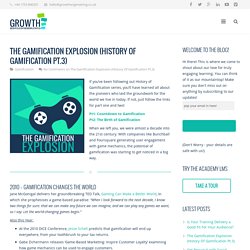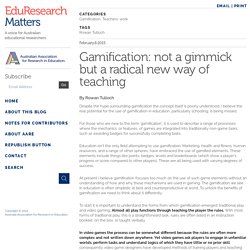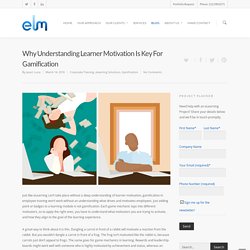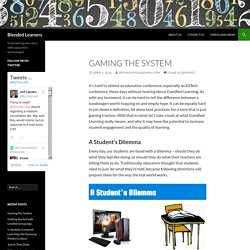

Hva skal vi med spillifisering? Avsender: Vi utfordrer førsteamanuensis Natalia Mæhle ved Senter for nyskaping hos Høgskolen i Bergen: 1.

Hva er spillifisering? - Spillifisering (gamification) er bruk av spillelementer og spillmekanismer i ikke-spillrelaterte sammenhenger, f.eks. innen undervisning eller i forretningssammenheng. Begrepet ble introdusert av den britiske programutvikleren Nick Pelling i 2002, men fikk først oppmerksomhet i 2010. Gamifying Learning. Steg for å bruke spillifisering i klasserommet. Spillifisering i klasserommet blir mer og mer viktig i den pedagogiske prosessen.

Spill er en grunnleggende del av kulturen. Og jo viktigere lek blir i læringen, jo større potensiale har spill for å transformere opplevelsene til barn i skolealder. Vi har mange ganger snakket om viktigheten av lek for barns læring og utvikling. Men nå vil vi snakke om hvordan vi kan dra nytte av lek for å utdanne barn i en pedagogisk omgivelse. Det er mange forskjellige pedagogiske metoder og meninger om hvordan du kan gjøre det. 6 Gamification Strategy Tips & Techniques for Your Business. Interaction Design Foundation (IxDF) We’ve all come to think in terms of user-centred design over the years. It’s a critical component of UX design, and it helps us focus on what really matters when developing products.
However, user-centred design is not enough for gamification. Here, we introduce the concept of player-centred design, which takes the idea of user-centred design to the next level. What was the first computer game you ever played? If you’re starting to enter middle age, it’s likely to have been something like Space Invaders or Pacman. Coping with Change Game play has changed, too, from ‘move left, move right and fire’ to being able to carry out incredibly complex actions. Author/Copyright holder: petsasjim1. Pacman was one of the earliest popular computer games, and while it’s still fun, today’s games are far more complex and engaging. Player-Centred Design Let’s kick off this topic by remembering that in any game, a fair degree of work is involved. Author/Copyright holder: BagoGames. The Take Away. 6 Killer Examples Of Gamification In eLearning (Updated In 2020) - Gamification for learning—or, notably, serious learning—is all about using the principles and key elements of gaming to meet the required learning objectives. eBook Release What Is Gamification And How Can It Enhance Corporate Training Discover real-world examples of how gamification can improve corporate training experiences.
The value that gamification brings in is summarized very effectively in the following statement as per Wikipedia: Steg for å bruke spillifisering i klasserommet. The Gamification Explosion (History Of Gamification Pt.3) If you’ve been following out History of Gamification series, you’ll have learned all about the pioneers who laid the groundwork for the world we live in today.

If not, just follow the links for part one and two! Pt1: Countdown to Gamification Pt2: The Birth of Gamification When we left you, we were almost a decade into the 21st century. With companies like Bunchball and Foursquare generating user engagement with game mechanics, the potential of gamification was starting to get noticed in a big way. Gamification: not a gimmick but a radical new way of teaching. Despite the hype surrounding gamification the concept itself is poorly understood.

I believe the real potential for the use of gamification in education, particularly schooling, is being missed. For those who are new to the term ‘gamification’, it is used to describe a range of processes where the mechanics, or features, of games are integrated into traditionally non-game tasks, such as awarding badges for successfully completing tasks.
Education isn’t the only field attempting to use gamification. Marketing, health and fitness, human resources, and a range of other spheres, have embraced the use of gamified elements. These elements include things like points, badges, levels and leaderboards (which show a player’s progress or score compared to other players), These are all being used with varying degrees of success. Why Understanding Learner Motivation Is Key For Gamification - eLearning Mind. Just like eLearning can’t take place without a deep understanding of learner motivation, gamification in employee training won’t work without an understanding what drives and motivates employees.

Just adding point or badges to a learning module is not gamification. Each game mechanic taps into different motivators, so to apply the right ones, you have to understand what motivators you are trying to activate, and how they align to the goal of the learning experience. Gamification: how it can engage and motivate your employees. Gaming the System.
It’s hard to attend an education conference, especially an EdTech conference, these days without hearing about Gamified Learning.

As with any buzzword, it can be hard to tell the difference between a bandwagon worth hopping on and empty hype. It can be equally hard to pin down a definition, let alone best practices, for a term that is just gaining traction. With that in mind, let’s take a look at what Gamified Learning really means, and why it may have the potential to increase student engagement and the quality of learning. A Student’s Dilemma Every day, our students are faced with a dilemma – should they do what they feel like doing, or should they do what their teachers are telling them to do.
Developments in the way we think about student learning have challenged these assumptions in several ways. 47 Gamification elements, mechanics and ideas. The Benefits of Gamification for Learning Reinforcement. Gamification is rapidly gaining traction in the learning industry as an effective way to increase knowledge retention and drive behavior change.

This new, innovative approach to training and learning reinforcement offers benefits for a wide-range of soft-skill and technical training reinforcement programs. If you are looking to increase the impact of your training programs and effectively drive behavior change, consider testing gamification based on the benefits outlined below. 1. Increases the Impact of Training & Reinforces Learning to Maximize Impact When it comes to traditional instructor-led training sessions and workshops, it can be difficult for participants to translate content for on-the-job application.
Gamification reinforces traditional training programs and eLearning courses by giving participants the opportunity to apply principles to real-life challenges and scenarios through a safe learning experience. 2. 3. Gamification.